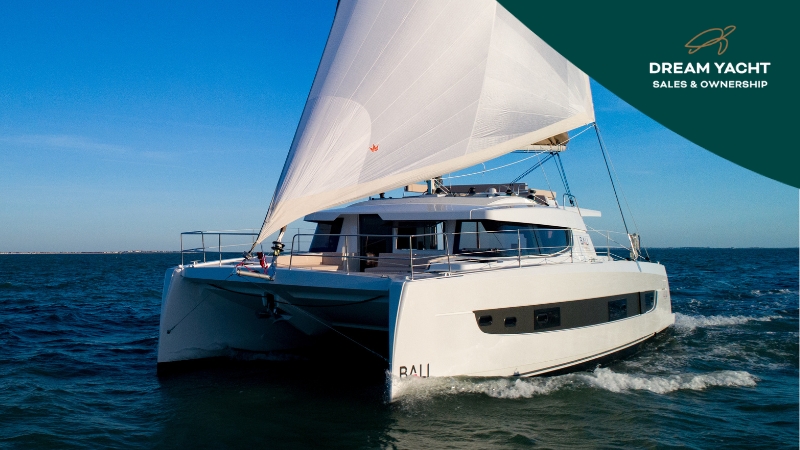
Nancy Ibison Sails South After Successful Fall Crew List Party
Richmond Yacht Club sailor Nancy Ibison scored a ride in the 2023 Baja Ha-Ha at Latitude 38’s Fall Crew List Party. Of course, that’s why we have the party, and our online Crew List. We’re thrilled to hear when people find boats to crew on, or owners find crew. We connected with Nancy recently, and she updated us on her sailing adventures. After returning from the Baja Ha-Ha, “I have (successfully) completed the 100-ton classes and am now back on the water. It was a great experience, and I really enjoyed Dan Leininger’s no-nonsense style plus huge Navy ship sea stories.” Dan teaches for Maritime Institute in Alameda.
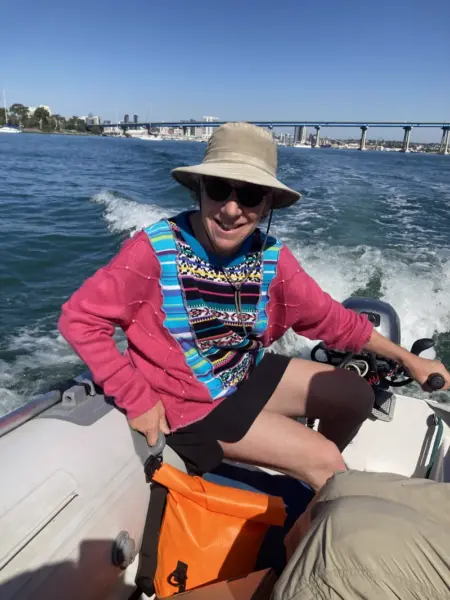
Asked about the Crew Party, Nancy explained, “I went to the Crew List Party for probably the third or fourth time this last fall and had my first success. On past occasions, I had my 9- to 12-year-old daughter along and was hoping to find a boat with other kids or folks interested in having a kid along, because, you know, kids see the world differently. Everything is magical through their eyes … on a good day. We never found the right boat full of adventurers for that trip. She is a teenager now, so she stayed behind — a different phase of life!
“This made me a free agent! The party was fun and high-energy as always; I mingled like my ride depended on it because it did. I talked to a bunch of very nice people and walked away feeling like I had struck out again. I handed out sailing résumés and everything.”
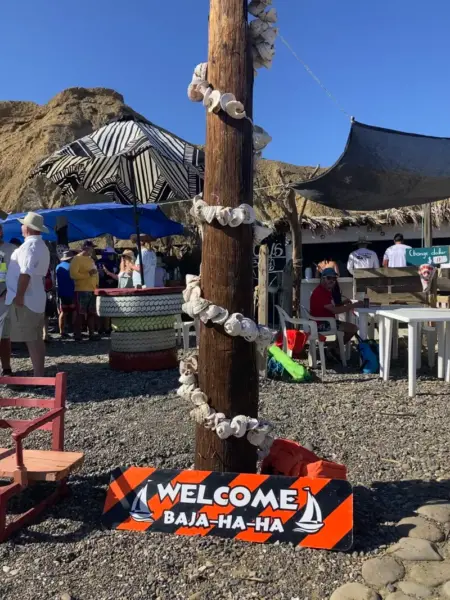
“Much to my surprise a couple of days later I got a text from Eve and Steve, who are the owners of Chat De Mer, a beautiful 43-ft Fountaine Pajot catamaran. They offered me not a bunk but a stateroom. We were excited to have found each other. We had a handful of organizing calls and emails, and then I showed up at the boat. I spent three nights on the boat in Santa Barbara before they came down. It was great to get to know where things were on board before we added the sailing-adventure part.”
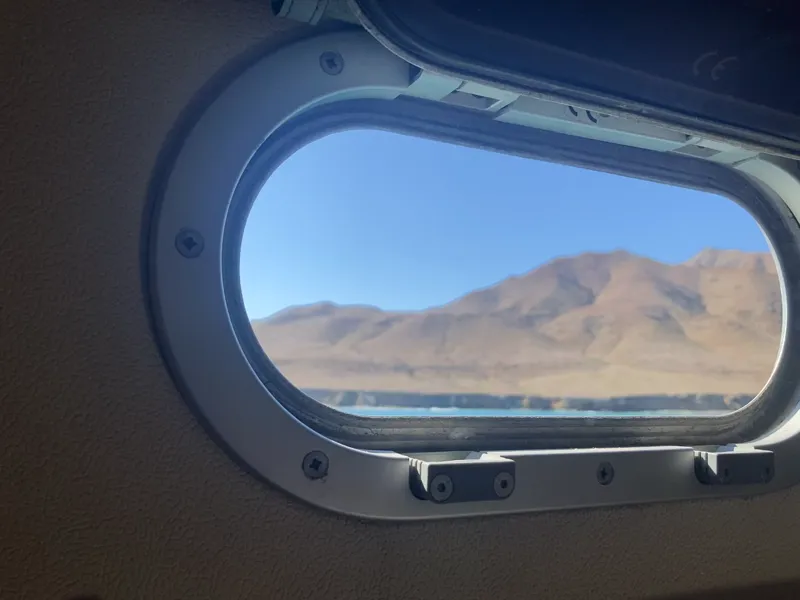
“The three of us overnighted to San Diego to get there for the opening Ha-Ha festivities. The morning of the start was beautiful, and everyone hoisted their spinnakers right out the gate. We were having one of those perfect sailing days. As the sun was getting closer to the horizon, the breeze picked up, and we decided to douse. We went forward, tethered on, and struggled with the spinnaker sock. As things often cascade, somehow, we ended up accidentally jibing and wrapping the spinnaker around the forestay. Well, that quieted things down. We two women came up to the bow (bows?) and carefully unwrapped the spinnaker. All good. We were humbled a bit as we stowed it down the hatch. The weather was perfect for kite flying the next day and pretty kites surrounded us, so we worked up the focus and courage to fly ours again. We sent it flying for the afternoon again, and we got it down, literally and figuratively. The three of us could do it!”
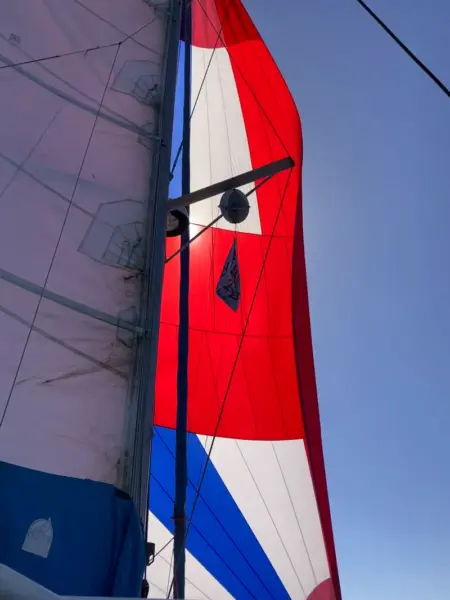
“From that day forward all the way to Puerto Vallarta was smooth sailing. No mishaps, for boat or crew. There are no crazy sea stories. Uneventful, save incredible sea life viewing from the back deck, delicious meals and some great beach music. The catamaran was a treat; she sailed brilliantly and was so luxurious. I was willing to work outside my monohull comfort zone and sail on a cat for a few weeks, and wow, it was nice! The three of us made it to hot, hot, hot Puerto Vallarta, tucked in the boat at Marina Vallarta, and flew home. She is there awaiting the next adventure with her lovely captains.”
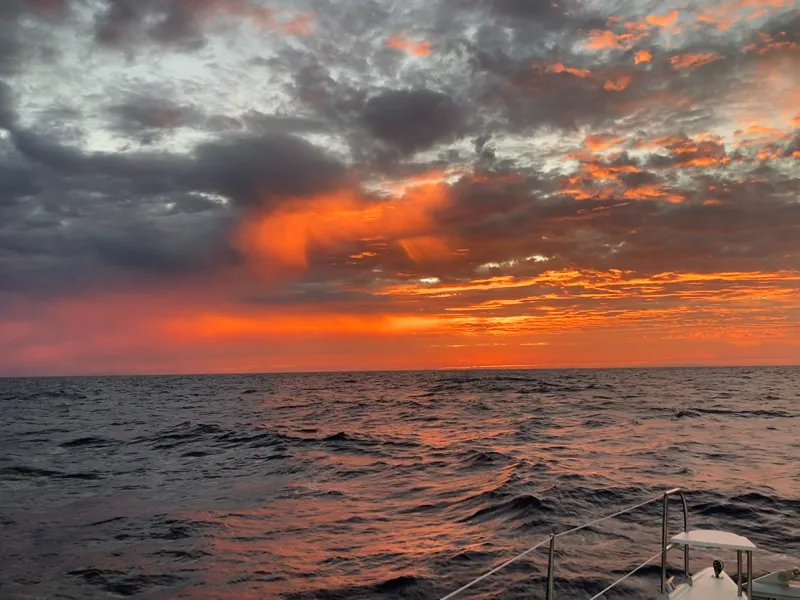
“And, I am available next November to crew on the Ha-Ha. I am now looking for space for a husband new to sailing, as well.”
We congratulate Nancy on a new-to-sailing husband, perseverance in finding a ride for the 2023 Ha-Ha, and a 100T license! Jan Pehrson featured Nancy in our November charter story; Nancy is now the owner of Jan’s former Islander 36 Hurulu!
Relax by reading our monthly print publication when you subscribe for yourself or a friend by clicking here.
When January Ends With a (Three Bridge) Fiasco
As of the registration deadline — Wednesday at midnight — we see 301 boats registered for tomorrow’s Three Bridge Fiasco. That’s not a record, but it’s still a lot of singlehanders and doublehanders to amass on the San Francisco Cityfront all at once.
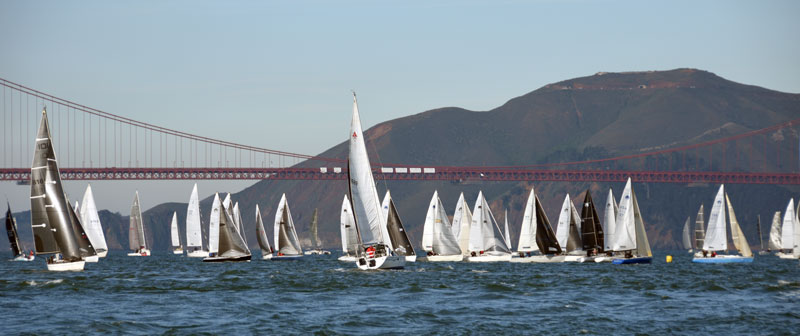
The organizers at the Singlehanded Sailing Society hosted a skippers’ meeting via Zoom on Wednesday night. Here’s what we learned.
The SSS commodore, Chris Case, opened the meeting. He mentioned that they’re a little short of volunteers to help out on the race deck at Golden Gate Yacht Club. “Come on down; we’d love to put you to work,” he said, inviting last-minute volunteers. They’re also looking for an assistant race officer for the year. “You can learn a lot from Richard,” he said, referring to the SSS race chair.
Richard then shared information specific to the race. “I put more stuff on Jibeset, including a summary of changes from last year.” Among the documents is a list of obstructions with latitude/longitude, a checklist for a better day on the water, and a table of start times based on PHRF (this is a pursuit race). He noted that, “Some people come to this race from Washington state or Southern California.
“Read the race documents; those are the rules,” said Richard. What you heard in the meeting or read in this post are not the official rules that govern the race.
Bring:
- Water.
- Food.
- Sunscreen.
- A watch or device that will show GPS-accurate time.
- Layers for the inevitably changing weather.
- A seat cushion (it’s a long race, and fiberglass is hard).
- An anchor (it’s not uncommon to use one in this race).
- An engine. You need to be able to quickly and safely escape the path of an oncoming ship, if necessary.
- A quarter. So you can flip it to decide which way to go!
Be sure to check in.
- The RC plans to be ready to accept check-ins by 8 a.m.
- Check in at least 10 minutes before your assigned start time.
- Get close to GGYC before you attempt to check in, and don’t step on your competitors’ check-ins. (Richard advises showing up early.)
- Check in on VHF 69 if your mainsail number ends in an odd number.
- Check in on VHF 70 if your mainsail number ends in an even number.
- Wait for a confirmation response from the race committee.
Three Bridge Fiasco Basics:
- The start and finish will be between GGYC on the San Francisco Marina and the yellow X buoy.
- The line is restricted to 50 yards unless you are starting or finishing.
- The SSS hopes to post watchers 50 yards from each side of the line holding red flags, but that will depend on the number of volunteers available.
- Start in either direction.
- Round the three marks in any order/direction.
- The three marks are:
- Blackaller Buoy, a yellow cylinder east of the South Tower of the Golden Gate Bridge.
- Yerba Buena/Treasure Island (Bay Bridge).
- Red Rock, south of the Richmond-San Rafael Bridge.
- You’ll be scored in your finish order (in most cases).
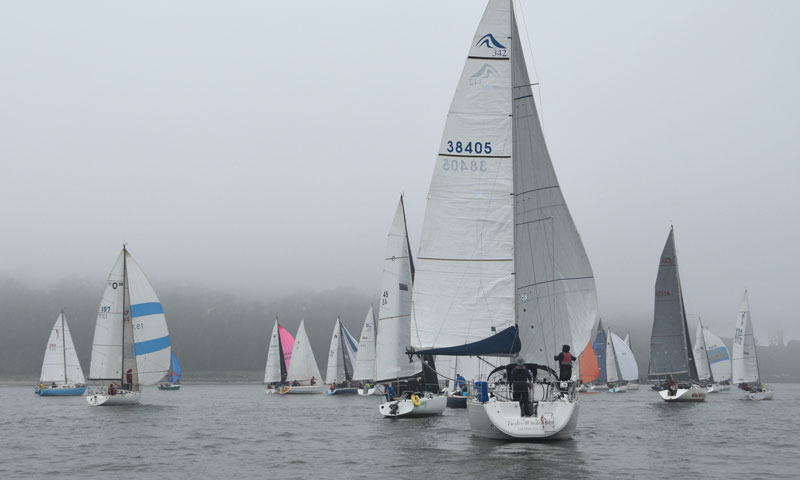
Starting Sequence Tips
- Your Warning is five minutes before your start time. Now you may approach the start line, but don’t cross it yet!
- Shut off your engine at least four minutes before your assigned start time. (This is your Prep time.)
- Once you’ve crossed the start line, keep sailing. You can’t clear an OCS (On Course Side) start by restarting.
- If you’re over early within your five-minute Warning time, the race committee will add 20 minutes to your finish time.
- There will be no flags or sounds, so make sure you have GPS time to follow.
- If you’re late for your start, that’s OK. You can start up to 10 minutes after the last assigned start time at 10:46:03. After that you’ll be scored DNS (Did Not Start).
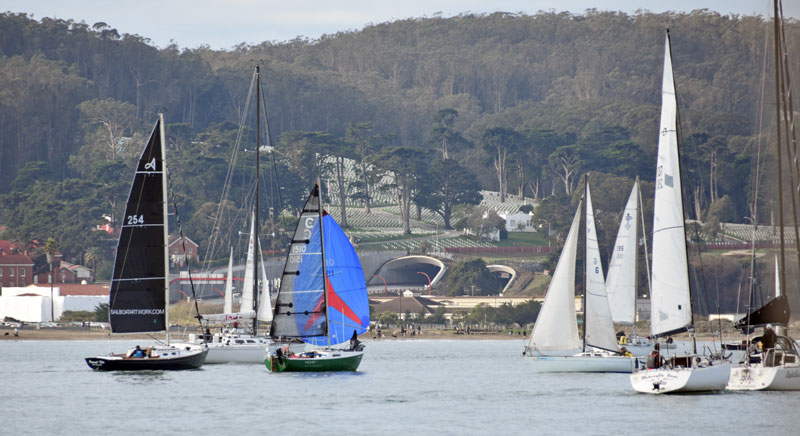
Those Pesky Restricted Areas
- On the Cityfront, don’t sail between the H Beam, Anita Rock or Anita Rock Offset and the beach.
- Beware hugging the shore on the south side of Yerba Buena Island. There’s a “box” protecting the Coast Guard Station there, demarcated by two white buoys (though one was missing recently).
- The Richmond Long Wharf, where tankers fuel up, is restricted by a triangle of three marks: Castro Rocks Buoy (CR, a red can), R2QR (another red can), and G3 (a green can). Consider this an “obstruction” — you have the right to call to a competitor for sea room here.
For the out-of-towners, some tips about currents:
- They’re stronger in the middle, lighter closer to shore.
- They reverse on shore first.
- Watch your competitors; they’ll give you a lesson.
- Study the charts.
- Know the tides and pay attention to your depth.
- We’ll be starting on a flood and ending on an ebb.
Strategery
Kame Richards used to give a briefing at the in-person skippers’ meetings, but he wouldn’t commit himself to predict a preferred course. Chris Case and some of the experienced sailors attending the meeting had the following tips:
- As a singlehander, avoiding crowds is an advantage. You’ll have better air and more options.
- Keep that anchor ready. “I’ve only deployed it once, but was glad I had it.”
- “I had a large jib up and didn’t have a smaller jib ready to go. So I was floundering with a sail change and got passed.”
- Be patient. “It can take 6-8 hours to sail half the course, then you might sail the rest in an hour and a half.”
- There are all different kinds of boats. Give a singlehander on a heavy boat some space. It can’t turn on a dime.
- Be flexible about your course and don’t get caught pinwheeling around a mark in a crowd.
- Beware the shallow bits (including rocks) around Red Rock.
As the Day Wears on…
- After 5 p.m. (1700 hours), hail the race committee as you approach the finish line — but not if you’re in a pack and someone else has already hailed.
- At sunset, remember to turn on your nav lights. If you don’t, you’ll be disqualified.
- If you finish after dark, light up your sails so that the RC crew knows who you are.
- If you don’t finish by 7 p.m. (1900 hours), you’ll be scored “DNF” (Did Not Finish).
- If you retire from the race, or don’t finish by 7, text Richard at (650) 380-0449 with your sail number, boat name and your retirement.
- He will confirm receipt of your text, but maybe not right away if things are super-busy at the time.
Chris reminded us: “How we get T-shirts has changed.” The SSS has gotten out of the T-shirt business and handed that duty over to Pirate’s Lair. You can order a Three Bridge Fiasco shirt here: https://store.pirateslair.com/singlehanded-sailing-society.
The SSS will keep skippers’ meetings online this year but plans to have an in-person awards meeting for each race. The one for Three Bridge Fiasco will probably be at least three weeks hence, and it may take up to a week for the results to be finalized. As with the race itself, patience is a virtue.
Weather or Not
The SSS briefing did not include a weather prediction. It’s up to each sailor to check the forecast and plan accordingly. Earlier in the week, the prognosticators were calling for a 40% chance of rain on Saturday, but that chance has evaporated. The wind predictions range from north to northeast in the mid- to high single digits. Hopefully there will be enough breeze to overcome the tugging of the full moon on the tides. For some links to weather, tides and currents, see the Local Info section of Latitude 38’s Links page.
Find all the documents, as well as the slide deck from Wednesday’s meeting, at www.jibeset.net/JACKY000.php?RG=T005347597. It pays to do your homework!
Get Your Own Catamaran Now
Dream Yacht has immediate availability for a beautiful BALI 4.4. catamaran to join the popular Dream Performance ownership program in select destinations in the Caribbean. Yacht ownership programs like Dream Performance can help you offset the cost of your yacht and take the hassle out of owning a boat.
Dream Performance at a glance:
– Rental income paid quarterly
– Possible Tax Advantages
– Extensive, flexible use of your yacht
– Comprehensive management with all-inclusive maintenance and services
With more destinations than any other charter company and 7 world famous yacht brands to choose from, Dream Yacht offers you more choice than anyone else.
Private ownership (retail) pricing is also an option for this yacht, starting in the mid 800Ks, and many of the other currently available models. Contact Dream Yacht Sales & Ownership for more details.
The Resourceful Sailor Asks, “Is It Varnish or Vanish?”
This installment of The Resourceful Sailor discusses the use and longevity of varnish versus paint on your boat’s wood surfaces. In our experience, most people will choose varnish — it’s traditional, it’s effective (for a time) and it looks great. But, having said that, this writer admits to having replaced varnish with paint on her own boat’s exterior trim work. Although she fought hard to keep the boat’s traditional appearance, her husband won out in the end, citing reasons very similar to those discussed below.
The Resourceful Sailor does not use varnish. Sampaguita, a 1985 Pacific Seacraft Flicka 20, has no brightwork on her. But watch the lookie-loos at the dock ogle a boat (that often never gets used) with shiny brightwork. Why? Aesthetic. The seductiveness of the bright and shiny. It is everywhere, not just with boats.
Little-known fact to a non-boater: Varnish is a serious time suck. I had a workmate, David White, whose sales pitch was that varnish was misspelled. It should really be spelled vanish. Because that’s what it does on a boat exposed to the sun’s UV radiation. After you sand and prep the surface, you need six to 10 coats of varnish, depending on your desired quality. Then you prep and recoat it with at least one coat every year. If, for some reason, you miss a year or — oh, no! — two years, you may have to sand it all off and restart.
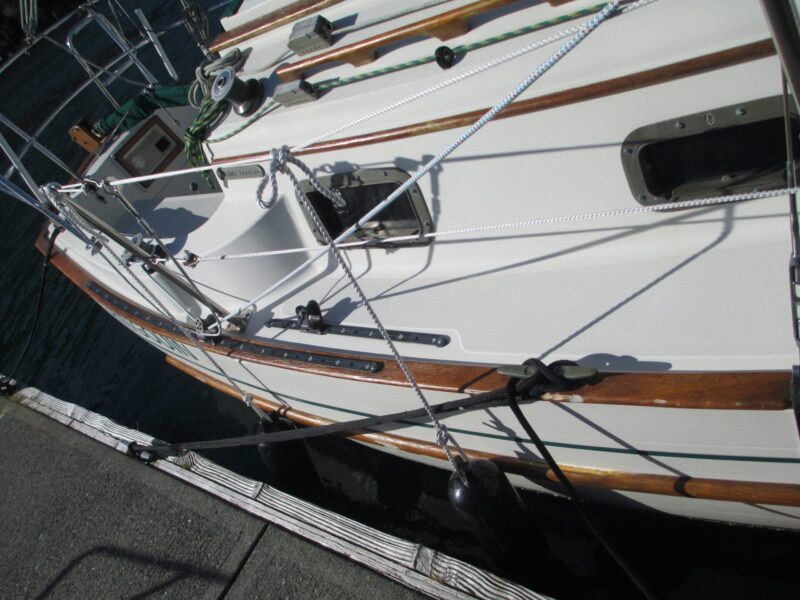
This needs good weather, which is also the best time of the year for using the boat. I watched a fellow Flicka owner spend all of July and half of August revarnishing his outside brightwork. After all that, he said he should put another coat on, but he’d let the new owners do that. I’ve heard it said that you should only varnish your boat once: right before you are going to sell it. What a setup for the new owners!
Varnish is for what The Resourceful Sailor calls trophy boats. Go to any wooden boat festival. Wow. If that is your economy and what is important to you, to each their own. But for The Resourceful Sailor, using the boat is what’s important. I’ve known tradespeople whose sole employment was doing brightwork on boats. They do the same jobs year after year.
Varnish does create a barrier that protects the wood. However, one of the reasons it needs so many coats is to stabilize the wood and the moisture content. To cut corners is a false economy. Instead, again, the words of David White, “Slather a few coats of paint on there and go sailing.” (Hilariously, nine times out of 10, they still bought the varnish!) It will protect nearly as well for much less time and work.
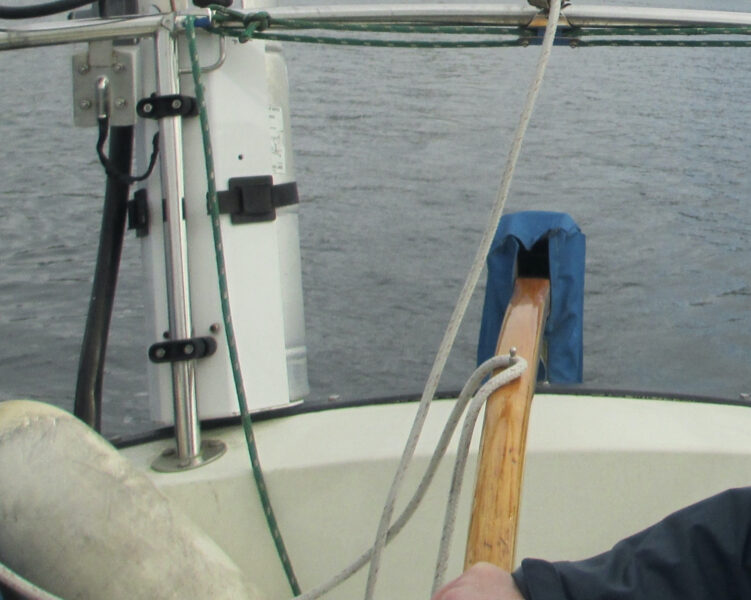
Admittedly, I used to varnish my tiller. It was that one shiny element. But having learned what that small experience was like year after year, when I replaced it, I moved to painting. Phew, way easier, way faster, and one less task to distract me each year. The old tiller, I still have as a spare. And I also painted that. Fact: Both are oil-based, so the paint can successfully be put over a stable coat of varnish. Admittedly, I’ve never tried to do it the other way.
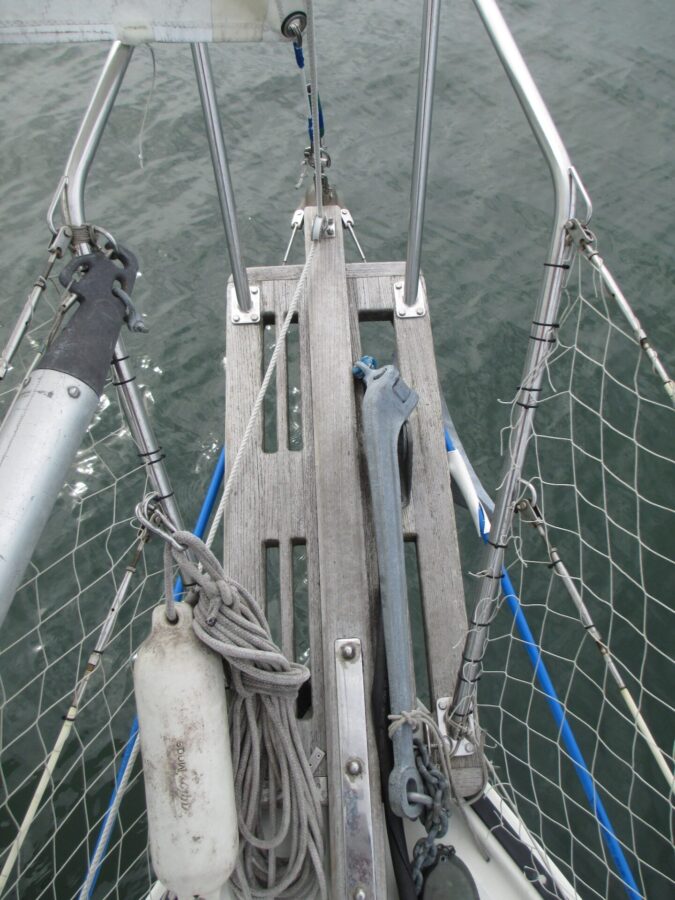
So, if you prefer using your boat over working on it, The Resourceful Sailor recommends paint over varnish. It’s not lazy if you actually go sailing. True, the lookie-loos will ogle your neighbor’s bright and shiny Flicka 20 rather than yours. The Resourceful Sailor doesn’t try to keep up with the Joneses but usually outsails them.
Remember, keep your solutions safe and prudent, and have a blast.
What is your preference for your boat’s timber work — varnish or paint? And why? Let us know in the comments below. Or if you have a lot to say, email us at [email protected].
Revisiting the 1927 Schooner ‘Northern Light’
As we approach the last days of January, we often find ourselves musing over the past decade or two. This usually leads us to revisit past issues of Latitude 38, just for a glimpse of what was going on “back then.” This time we landed on page 118 of the January 2004 issue, where a photo of a large-looking boat caught our attention. We looked to the start of the story and discovered that she was indeed large — 140-ft long, launched at Stone Boat Yard in Alameda in 1927. Her name was Northern Light, and at that time, we reported she was the “largest schooner ever built on the West Coast — and possibly the largest sailing yacht, period.”
Northern Light was the creation of John Borden, a millionaire who owned Chicago’s Yellow Cab Company. He wanted a boat for an Arctic cruise to gather specimens for Chicago’s Field Museum. Borden contacted Lester (son of Stone Boat Yard founder William F. Stone) in 1926 — less than a year before his deadline of May 1, 1927.
According to a 1992 article in WoodenBoat magazine, 46 men went to work on the project. The decked hull was launched in January ’27. But there was now a new deadline for completion — April 20. Two crews worked 10-hour shifts to finish the job, and the boat was delivered on April 21. Northern Light reportedly left for the Arctic the same day.

There is a story to accompany the boat’s 11,000-mile cruise, chronicled in the pages of The Cruise of the Northern Light, written by Borden’s wife and published under the name Mrs. John Borden.
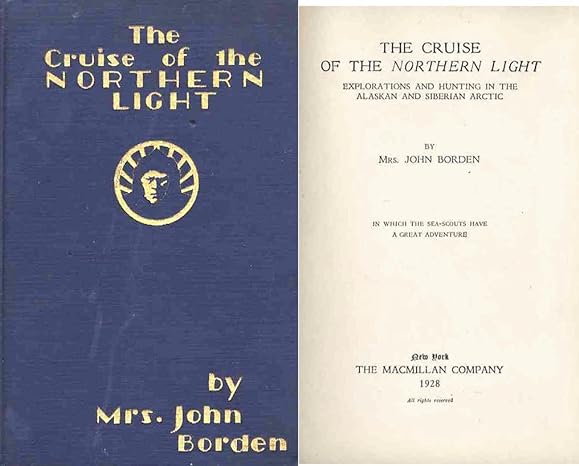
In the meantime, you can read our story of the Northern Light build and cruise in Latitude 38‘s January 2004 issue.

